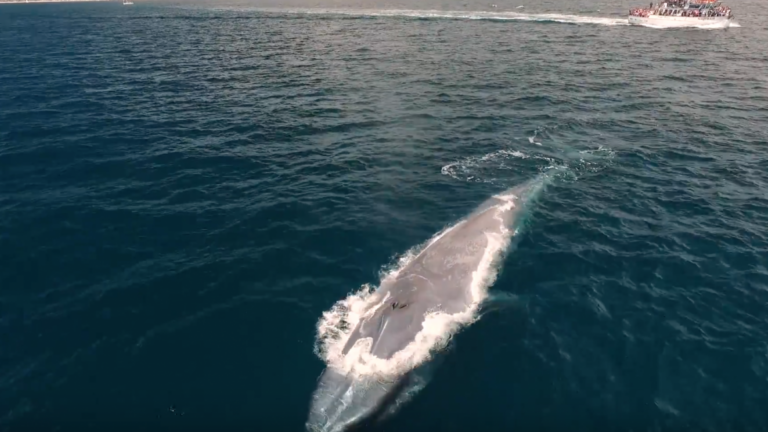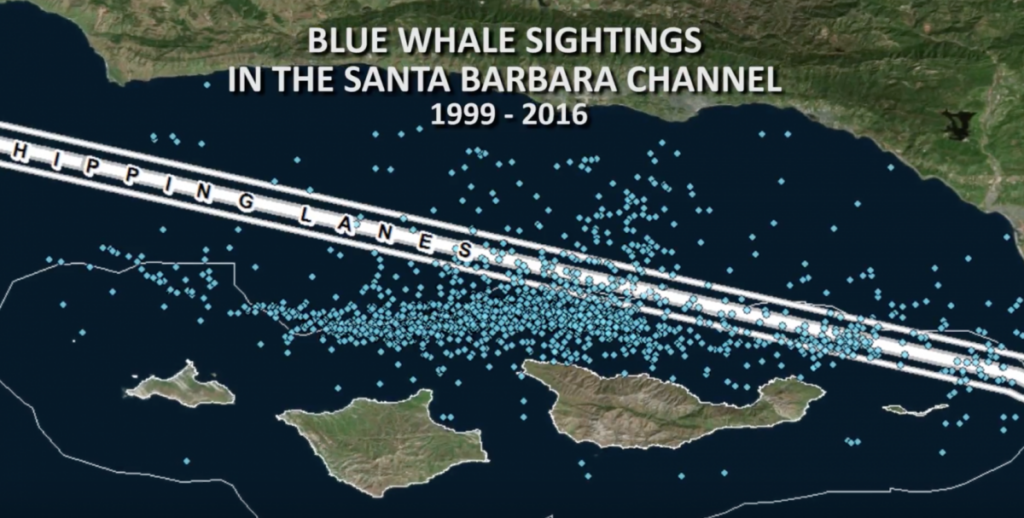
Protecting Blue Whales and Blue Skies
Phyllis Grifman, USC Sea Grant’s Associate Director, presented at the January 26 summit meeting of the Marine Protected Area (MPA) Federal Advisory Committee and all 14 Chairs of the Marine Sanctuary Advisory Councils. The meeting was a chance to discuss emerging issues facing MPAs around the nation and to identify the benefits of future cross collaborations. Ms. Grifman’s presentation focused on work that emerged from the Channel Islands Marine Shipping Working Group to discuss solutions to whale-ship interactions in the Santa Barbara Channel.
Thousands of cargo ships transit along the California coast and through the national marine sanctuaries off California each year en route into and out of the Ports of Los Angeles, Long Beach, Port Hueneme, San Francisco and Oakland. California sanctuaries are seasonal feeding grounds and aggregation hotspots for three species of endangered whales: blue; humpback; and fin. There are many overlapping ocean users in California waters including fishing grounds, oil rigs, and the Point Mugu Sea Range – the Department of Defense’s largest and most extensively instrumented over-water missile testing range.

The presence of vessels and changes in traffic patterns present four local management challenges: ship strikes on endangered whales; air pollution and greenhouse gas emissions impacting air quality; navigational safety concerns; and conflicts with other ocean uses, such as Department of Defense operations.
Sanctuaries have been involved with reducing the risk of ship strikes since an unusual mortality event of blue whales in the Santa Barbara Channel region in 2007. The Channel Islands Marine Shipping Working Group (MSWG), co-chaired by Ms. Grifman, convened from 2015-2016 and was charged with crafting advice in the form of management, education, outreach, and research recommendations or proposals that address each of the following four goals:
- Reduce the risk of ship strikes on endangered whales;
- Decrease air pollution and greenhouse gas emissions;
- Improve navigational safety and promote efficient maritime shipping throughout the region;
- Manage ship traffic to minimize Naval operation interruptions and reduce conflicts with other ocean users (e.g. fishing and whale watching concessionaires).
Members of the MSWG include the wide range of stakeholders in the region–from Department of Defense to the National Park Service, international shipping companies to Santa Barbara County Air Pollution Control District, and more. Dr. James Fawcett, USC Sea Grant’s Maritime Transportation Specialist and Extension Director, also participated in the group.
One of the recommendations proposed by the MSWG was expanding an incentive-based Vessel Speed Reduction Incentive program. The program provides monetary incentives to shipping companies to reduce speeds when whales are in their transit routes. Slower ship speeds reduce the incidences of ships striking endangered whales, reduce whale mortality, and also reduce harmful air quality. It’s been piloted over a three-year period, with eleven shipping companies now participating and 202 ship transits incentivized to slow down.
The program has been a great pilot effort and collaboration that shows significant promise if sustainable funding can be secured. In addition to whale conservation and reducing air pollution, reducing ocean noise– although not an explicit goal–is also a benefit of slowing ships down and the MSWG is considering how best to gauge this additional benefit. View Ms. Grifman’s presentation about the Vessel Speed Reduction Incentive program here; and for more information, visit here.
Highlight Video
View a wonderful 7-minute video about this issue by the Santa Barbara County Air Pollution Control District below.